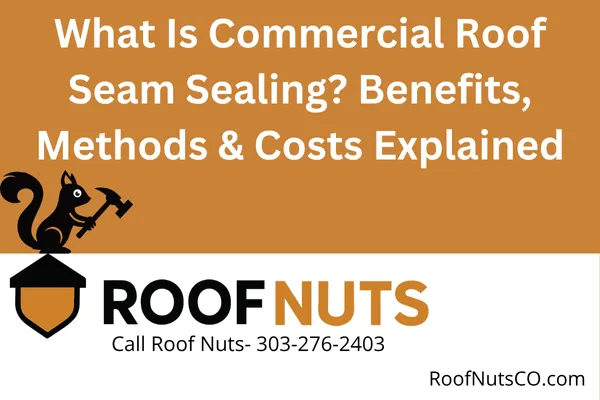
What Is Commercial Roof Seam Sealing? Benefits, Methods & Costs Explained
Commercial Roofing Seam Sealing: What You Need to Know
If you own or manage a commercial building, your roof is one of your most valuable assets. Seam sealing is a critical part of protecting that investment.
Here’s what commercial property owners in Denver, Colorado Springs, Atlanta, and beyond need to know about seam sealing for flat and metal roofs.
What Is Seam Sealing in Commercial Roofing?
Seam sealing is the process of applying sealant over roof seams and joints to prevent water intrusion.
Most commercial roofs — especially flat or low-slope systems — have seams between sheets of roofing membrane or metal panels. These seams are often the first place where leaks start.
Why Seam Sealing Matters
Unsealed or aging seams can lead to:
Water leaks into your building
Mold and moisture issues
Damaged insulation and energy loss
Shortened roof lifespan
Costly interior damage and repairs
Proper seam sealing helps:
Keep water out
Prevent thermal bridging
Reduce HVAC load
Delay the need for full roof replacement
Best Seam Sealing Methods by Roof Type
For Flat Roofs (TPO, EPDM, Modified Bitumen)
Liquid-applied sealants: Usually a silicone, acrylic, or urethane coating brushed or rolled over seams.
Reinforced tapes: Self-adhesive tapes made from reinforced fabric or butyl rubber, often used for EPDM.
Heat-welded seams: Often used during original TPO or PVC installations, but sealant may still be needed later at penetrations or after aging.
For Metal Roofs
Butyl or polyurethane sealants: Applied to panel laps, fasteners, and ridge caps.
Tape sealing: Used under panel overlaps and at closures.
Standing seam panel mastic: Factory-installed or field-applied to maintain watertight seals under movement.
When Should You Seal or Reseal Roof Seams?
During roof installation or after major repair work
Every 5–10 years as part of a routine maintenance plan
After hail, snow, or wind storms
If you notice water stains, bubbling, or loose seams
In Colorado and Georgia, where hail and sun exposure are common, regular inspections are key.
How Much Does Seam Sealing Cost?
Pricing varies based on:
Roof size
Type of roofing system
Type of sealant used
Accessibility of the roof
Local labor rates
Average cost range:
$1 to $4 per linear foot of seam sealed
$0.50 to $2.00 per square foot for full surface sealant coatings
Choosing the Right Commercial Roofing Contractor
Hire a licensed, experienced commercial roofer who:
Knows local building codes
Works with all major commercial roof types
Uses products approved by the roofing manufacturer
Provides warranties and maintenance plans
Roof Nuts CO and Roof Nuts GA offer seamless repairs and preventative maintenance tailored for businesses.
FAQs
How long does seam sealing last?
With proper prep and product, 5 to 15 years depending on UV exposure and weather conditions.
Can you reseal seams instead of replacing the whole roof?
Yes. Seam sealing is often a cost-effective alternative to full replacement if the rest of the system is sound.
What sealant is best for metal roof seams?
High-quality butyl-based sealants or tape sealants are durable and flexible under expansion and contraction.
Need help inspecting or sealing your commercial roof?
Call Roof Nuts Today:
Colorado: 303-276-2403
Or visit RoofNutsCO.com
We protect your property like it's our own — with smart, proactive roofing solutions.
